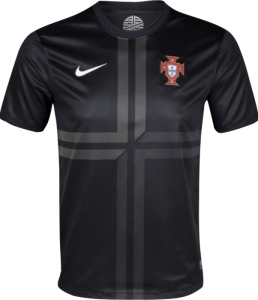TEAM: Portuguese national team
SEASON: 2013/14
TYPE: Away kit
MANUFACTURER: Nike

The smart-looking Portugal away kit from 2013 featured an attractive, minimalist design by Nike. PHOTO: Footballkitnews.
TEAM: Bayern Munich, Germany
SEASON: 2014/15
TYPE: Away kit
MANUFACTURER: Adidas
TEAM: Borussia Dortmund, Germany
SEASON: 2012/13
TYPE: Home kit – UEFA Champions League edition
MANUFACTURER: Puma

German giants, Borrusia Dortmund are sponsored by Puma. This is the Champions League edition of their 2012-13 home kit. Strong contrast between the black and yellow, unusual collar. PHOTO: Puma
TEAM: Palermo, Italy
SEASON: 2012/13
TYPE: Home kit
MANUFACTURER: Puma

Palermo’s classy pink fit with an elegant blank collar and sleeve trim. Note the fade-in of checkered squares in the mid-section. PHOTO: Footballkitnews.com
TEAM: AS Roma, Italy
SEASON: 2013/14
TYPE: Home kit, Away kit
MANUFACTURER: Nike

AS Roma’s home and away kits for the 2013/14 season were met with an overwhelming positive reception. The simplicity of the Italian team’s home kit (left) and the away kit (right) made them one of Nike’s best ever designs. PHOTO: World Soccer Talk.
TEAM: FC Barcelona, Spain
SEASON: 2012/13
TYPE: Home kit
MANUFACTURER: Nike

Barcelona’s Nike-made home kit for 2012/13 made use of a smooth gradient to transition in the red and blue colours of Barca. PHOTO: Football Fashion.
TEAM: Manchester City FC, England
SEASON: 2012/13
TYPE: Away kit
MANUFACTURER: Umbro

Manchester City’s away jersey for the 2012/13 season. Designed by Umbro (owned by Nike). PHOTO: Pro-Direct.
TEAM: Arsenal FC, England
SEASON: 2013/14
TYPE: Away kit
MANUFACTURER: Nike

Nike’s retro-coloured away jersey for Arsenal in the 2013/14 season was a special one. Note the use of complimentary colours (the shorts were blue and the socks had rings of yellow and blue). PHOTO: World Soccer.
TEAM: Real Madrid, Spain
SEASON: 2011/12
TYPE: Home kit
MANUFACTURER: Adidas

Real Madrid’s famous white strip has been the envy of many clubs around the world. In their league-winning 2011/12 season, Adidas released the home kit – featuring a classy gold trim to the shoulders, sides and sleeves. One of their best kits. PHOTO: Footy-Boots.
TEAM: Paris St Germain, France
SEASON: 2013/14
TYPE: Home kit
MANUFACTURER: Nike

Paris St Germain’s Nike-made home kit from 2013/14 pays homage to the French tricolour. A classy design that stands out, worn by players such as Zlatan Ibrahimovic and david Beckham. PHOTO: UK Soccer Shop.
TEAM: Liverpool FC, England
SEASON: 2012/13
TYPE: Home kit
MANUFACTURER: Warrior

Liverpool’s 2012/13 vintage home kit. Made by Warrior, the retro collars are a reference to their famous history. PHOTO: Liverpool FC.
TEAM: AC Milan, Italy
SEASON: 2011/12
TYPE: Home kit
MANUFACTURER: Adidas

The 2011/12 home kit of AC Milan was a beautiful kit, with the elegant use of white trim at the sleeve’s end, the neck and shoulders complimenting the primary red and black stripes. PHOTO: Adidas
TEAM: Netherlands national team
SEASON: 2013/14
TYPE: Away kit
MANUFACTURER: Nike

The electric blue kit of the Netherlands was a hit at the recent world cup. Note the clever use of orange (Dutch primary colours) on the badge, logo and numbering on the reverse. PHOTO: Soccerbox.com
TEAM: Columbia national team
SEASON: 2013/14
TYPE: Home kit
MANUFACTURER: Adidas

Columbia’s home jersey for the 2014 Brazilian World Cup. PHOTO: Columbiasoccershop.com
TEAM: Manchester United FC, England
SEASON: 1998/99
TYPE: Home kit
MANUFACTURER: Umbro

Manchester United’s famous home kit from the 1998/99 season when they won the treble. Note the vintage design (collars, sleeve trim, etc). PHOTO: Manchester United FC.


































